
views
Providing Birds with Food
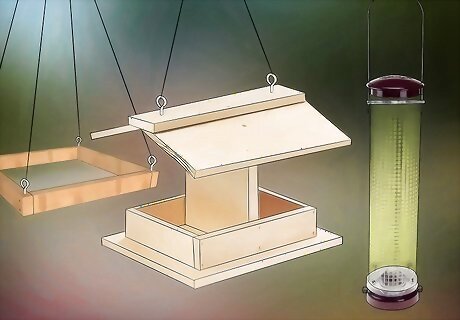
Choose appropriate feeders. In order to decide on suitable feeders, you should research the types of birds in your area. This way, you can purchase a feeder that is appropriate for local birds. Regardless of the type of feeder you choose, make sure that you clean it regularly and replace the seeds every 2 to 3 days to prevent the development of harmful fungi and bacteria. Here are the most common types of feeders and some of the types of birds they will attract to your garden: Tray feeders: Attract pigeons, starlings, and sparrows. Use a tray feeder that has a screened, rather than solid, bottom in order to allow for drainage. Water build up after rain can cause seeds to rot and facilitate the development of bacteria. Also bird droppings can contaminate the food. House feeders: Attract finches, blue jays, cardinals, buntings, grosbeaks, sparrows, chickadees, and titmice. The feeders are covered and, therefore, the seeds are protected from water and droppings. You can mount hopper feeders on a pole or suspend them from a tree. Tube feeders: Are cylindrical feeders with tiny feeding holes to allow for smaller seeds, such as Nyjer. These feeders often have small perches and attract smaller birds such as finches, sparrows, titmice, chickadees, and grosbeaks. Suet feeders: Are constructed of wire or plastic mesh and can be nailed or tied to a tree trunk, suspended, or attached to a hopper feeder. These feeders attract woodpeckers, nuthatches, chickadees, blue jays, and starlings.
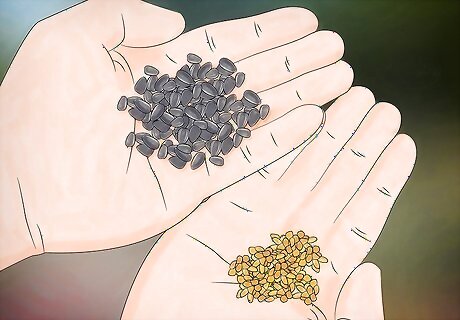
Provide a variety of bird food. Different types of birds eat different types of food. If you want to attract a variety of birds to your yard, you will need to put out multiple feeders with different types of seeds. For instance, try sunflower seeds, nyger seeds, seed mixes, suet, and nectar. Use these helpful tips in order to choose the food that is best for the birds within your local area: Sunflower seeds: Are the most popular seeds and will attract a large variety of birds to your garden including blue jays, cardinals, finches, chickadees, nuthatches, and sparrows. You can also purchase sunflower seeds that have already been removed from their shells in order to avoid a large mess beneath your feeder. Nyjer seeds: Are very small, high quality seeds that attract a variety of finches, indigo buntings, pine siskins, and common redpolls. Because these seeds are so small, they require a special feeder with smaller holes, such as a tube feeder. Seed mixes: Are popular among new birders because they offer a variety of seeds and attract a range of bird species. They can be quite messy, though, because birds will pick through the seeds to find what they like. This behaviour will attract ground feeders such as doves, juncos, sparrows, and even squirrels. Suet: Is a great source of protein for birds, especially during the winter months. It consists of a cake of animal fat that is sometimes covered in seeds. In order to provide birds with suet, you will need to use a special suet feeder. Suet will attract woodpeckers, nuthatches, wrens, and jays, and starlings. Nectar: Is a combination of sugar and water and requires a special feeder. Typically, nectar is used to feed hummingbirds. To make hummingbird nectar you will need to dissolve one part sugar into four parts hot water. Let the mixture cool to room temperature before putting it into the feeder. Jelly or oranges: Are used to attract orioles. Use a specialty oriole feeder and bird-safe jelly or jam. If you'd rather not provide preserves, cut oranges will also attract this songbird.

Install feeders in a safe location. You should install your feeder in a safe space in order to avoid window collisions and predators. Feeders should be installed either within 1 meter (3 feet) of a window or more than 9 meters (30 feet) away from a window in order to prevent death from collision. You should also situate feeders relatively close to natural shelter such as trees or shrubs in order to provide both a resting place and quick shelter if a hawk or predator bird is in the area. That being said, don’t place the feeder too close to the bushes because they can also provide a hiding place for other predators. A distance of about 3 meters (10 feet) is ideal.
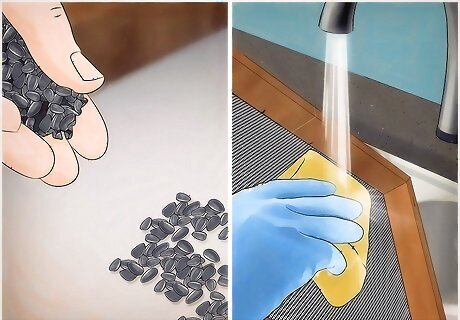
Maintain your feeders. It is important to change bird seed regularly (typically every 2 to 3 days) and wash the feeder with soap and water every few weeks. This will help remove any harmful bacteria and fungi that can develop as a result of stagnant water and bird droppings. It is especially important to clean feeders regularly during periods of rainy or wet weather.
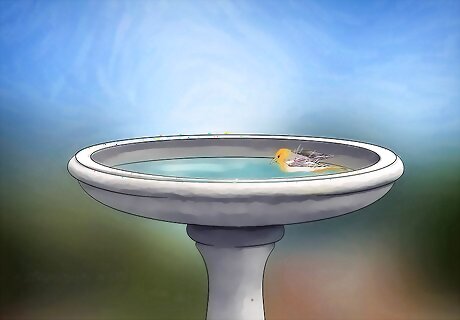
Add a water feature to your garden. Birds need a fresh, clean source of water for drinking and bathing. Setting up a water source will help to attract birds to your garden. Use a bird bath that is 2.5-10cm (1-4 inches) deep in order to attract a variety of different species. Alternatively, a pond or large fountain will also attract birds to your garden. Add rocks or twigs to the bird bath in order to provide a spot for birds to perch. Birds are attracted to the sound of running water, so a fountain may help get more birds into your garden. Change water in a bird bath every 2-3 days and place the baths 3 meters (10 feet) from dense cover that predators may use for hiding.
Creating Spaces for Nesting
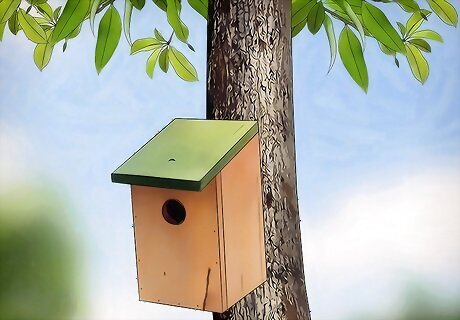
Hang a nest box. You can help attract birds to your garden and encourage them to stay and nest by hanging up nest boxes. Nest boxes can be purchased at local pet supply stores. These boxes come in multiple different varieties and some boxes are more suitable to nesting than others. Take these tips into consideration when shopping for a nest box for your garden: Choose a box made with insulating material. Look for a nest box made from thick wood (15-19mm thick) such as cedar, oak, or beech. Thinner woods, such as pine will not last as long. A nest box made out of ceramic will likely be too hot or too cold for chicks to survive. Choose a box that is the right size for the bird you want to attract. Different birds will need different sized nest boxes. Do not get a box with a perch. Perches are not necessary for nest boxes and can actually provide a way for predators such as weasels to access eggs and chicks living in the nest box. You can also make your own nesting box.
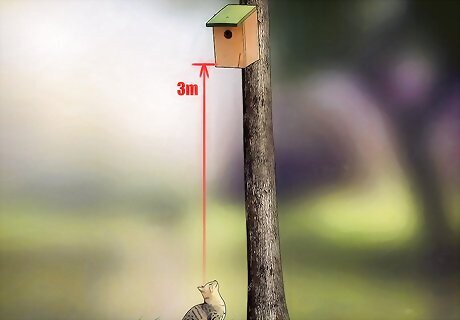
Install the nest box in a safe and quiet location. Nest boxes should be hung up early in the spring before birds begin to nest. It is very important that you choose a safe location so that birds will feel safe and remain nesting in your garden each year. Situate your nest box at least 3 meters off the ground and in an area that is sheltered from the weather. Make sure that nest boxes are not positioned too close to bird feeders or other nest boxes because this may lead to competition, and too much activity in the area could disrupt a nesting pair. Clean out the nest box once a year to encourage occupancy.

Provide birds with nesting materials. Help birds with nest-making by putting out materials they can use to build their nests. You can purchase nesting materials such as wool and string or you can gather your own nesting material and place it in the garden for the birds. For example, you can provide birds with pet hair, lint, or grass clippings. Just place the materials into the hollow of a tree or attach them to a pile of twigs.
Providing a Natural Habitat for the Birds
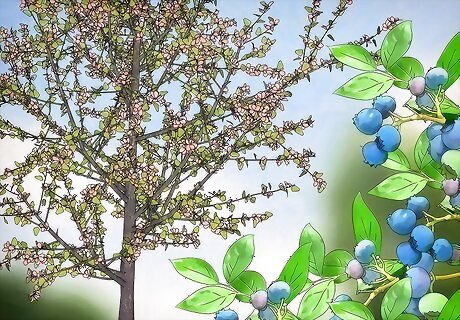
Plant native trees and shrubs. Local birds love native plants because they provide a great food source. Habitat loss is one of the leading causes of population declines among birds, and as a result, it is very important to grow native plant species. Select a variety of native plants that will offer birds year round food in the form of berries, nuts, and nectar. The best way to create a plentiful garden year round, is to mimic the plant ecosystem native to the area. Plants will also give birds shelter from potential predators, and natural nesting sites. Here are a few plant suggestions: Black-eyed Susans and Sunflowers: Are an excellent source of food for some birds because their seeds and flowers are edible. Ferns, thistles, and sumacs: Are great for producing materials that birds use while constructing nests. Crabapples, Dogwoods, and Serviceberries: Are a great source of food and provide birds with small edible fruits and berries. Coniferous trees: Pines and Spruce trees, for example, provide birds with cover and protection from predator species as well as sap and seeds for eating. They also make great nesting sites for many birds. Deciduous trees: Oak, Cherry, and Hickory trees, to name a few, provide birds with nesting sites as well as multiple food sources. For instance, these trees often produce edible nuts and are home to a variety of insects.
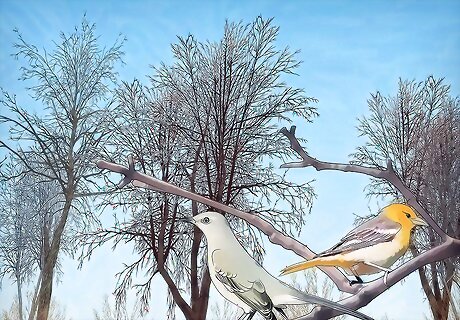
Keep dead trees in your garden. Dead trees can provide birds with a source of shelter and food. For example, dead trees will often contain hollow areas and alcoves that birds can use for nesting or to seek shelter from the weather. Insects are also often found on dead trees and can provide birds with a great source of food.
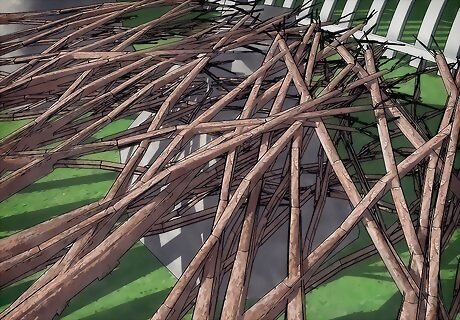
Create a brush pile. Brush piles can provide birds with an area to hunt, roost, and even nest. Begin by putting down a few large logs, then add some smaller branches and leaves. This is relatively easy and can be a great way to make use of garden clippings after you have pruned the trees, hedges, and shrubs in your garden. Brush piles also contain many insects and will provide ground feeders with an excellent food source. For instance, some bird species will never land on, or use, a bird feeder because they like to eat insects off the ground. Robins, Towhees, and Thrashers, for example, will use these piles as a food source.
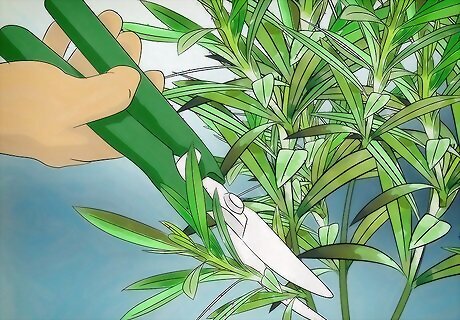
Remove invasive plant species from your garden. Invasive plants will compete with native plants for space, water, and sunlight. They can often out-compete the plants that are preferred by local bird and insect populations. As a result, you should minimize and remove the number of invasive species that are planted within your garden.
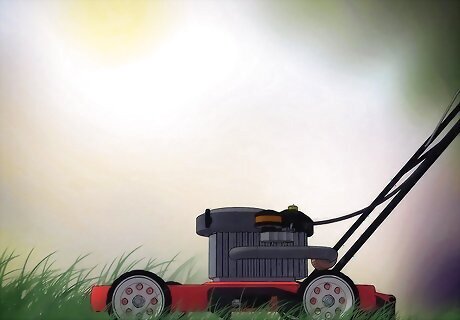
Reduce the lawn area in your yard. Large areas of manicured lawn provides very little of substance for bird populations. If you want to attract birds to your garden, you should reduce the lawn area and ensure that the garden is filled with local plants, water sources, and feeders. Manicured grass is essentially wasted space and requires more maintenance in the form of mowing, watering, and fertilizing.


















Comments
0 comment